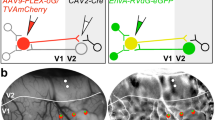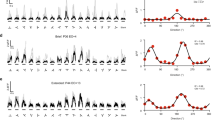Abstract
The cytoarchitectonic similarities of different neocortical regions have given rise to the idea of 'canonical' connectivity between excitatory neurons of different layers within a column. It is unclear whether similarly general organizational principles also exist for inhibitory neocortical circuits. Here we delineate and compare local inhibitory-to-excitatory wiring patterns in all principal layers of primary motor (M1), somatosensory (S1) and visual (V1) cortex, using genetically targeted photostimulation in a mouse knock-in line that conditionally expresses channelrhodopsin-2 in GABAergic neurons. Inhibitory inputs to excitatory neurons derived largely from the same cortical layer within a three-column diameter. However, subsets of pyramidal cells in layers 2/3 and 5B received extensive translaminar inhibition. These neurons were prominent in V1, where they might correspond to complex cells, less numerous in barrel cortex and absent in M1. Although inhibitory connection patterns were stereotypical, the abundance of individual motifs varied between regions and cells, potentially reflecting functional specializations.
This is a preview of subscription content, access via your institution
Access options
Subscribe to this journal
Receive 12 print issues and online access
$209.00 per year
only $17.42 per issue
Buy this article
- Purchase on Springer Link
- Instant access to full article PDF
Prices may be subject to local taxes which are calculated during checkout







Similar content being viewed by others
Accession codes
References
Mountcastle, V.B. An organizing principle for cerebral function: the unit module and the distributed system. in The Mindful Brain (ed. Mountcastle, V.B. & Edelman, G.M.) 7–50 (MIT Press, 1978).
Koralek, K.A., Jensen, K.F. & Killackey, H.P. Evidence for two complementary patterns of thalamic input to the rat somatosensory cortex. Brain Res. 463, 346–351 (1988).
Shepherd, G.M. & Svoboda, K. Laminar and columnar organization of ascending excitatory projections to layer 2/3 pyramidal neurons in rat barrel cortex. J. Neurosci. 25, 5670–5679 (2005).
Barbour, D.L. & Callaway, E.M. Excitatory local connections of superficial neurons in rat auditory cortex. J. Neurosci. 28, 11174–11185 (2008).
Weiler, N., Wood, L., Yu, J., Solla, S.A. & Shepherd, G.M. Top-down laminar organization of the excitatory network in motor cortex. Nat. Neurosci. 11, 360–366 (2008).
Gilbert, C.D. & Wiesel, T.N. Morphology and intracortical projections of functionally characterised neurones in the cat visual cortex. Nature 280, 120–125 (1979).
Gilbert, C.D. & Wiesel, T.N. Functional organization of the visual cortex. Prog. Brain Res. 58, 209–218 (1983).
Douglas, R.J. & Martin, K.A. Neuronal circuits of the neocortex. Annu. Rev. Neurosci. 27, 419–451 (2004).
Douglas, R.J. & Martin, K.A. Mapping the matrix: the ways of neocortex. Neuron 56, 226–238 (2007).
Gupta, A., Wang, Y. & Markram, H. Organizing principles for a diversity of GABAergic interneurons and synapses in the neocortex. Science 287, 273–278 (2000).
Markram, H. et al. Interneurons of the neocortical inhibitory system. Nat. Rev. Neurosci. 5, 793–807 (2004).
Gibson, J.R., Beierlein, M. & Connors, B.W. Two networks of electrically coupled inhibitory neurons in neocortex. Nature 402, 75–79 (1999).
Blatow, M., Caputi, A. & Monyer, H. Molecular diversity of neocortical GABAergic interneurones. J. Physiol. (Lond.) 562, 99–105 (2005).
Sun, Q.Q., Huguenard, J.R. & Prince, D.A. Barrel cortex microcircuits: thalamocortical feedforward inhibition in spiny stellate cells is mediated by a small number of fast-spiking interneurons. J. Neurosci. 26, 1219–1230 (2006).
Somogyi, P. & Klausberger, T. Defined types of cortical interneurone structure space and spike timing in the hippocampus. J. Physiol. (Lond.) 562, 9–26 (2005).
Helmstaedter, M., Sakmann, B. & Feldmeyer, D. Neuronal correlates of local, lateral, and translaminar inhibition with reference to cortical columns. Cereb. Cortex 19, 926–937 (2009).
Dantzker, J.L. & Callaway, E.M. Laminar sources of synaptic input to cortical inhibitory interneurons and pyramidal neurons. Nat. Neurosci. 3, 701–707 (2000).
Thomson, A.M., West, D.C., Wang, Y. & Bannister, A.P. Synaptic connections and small circuits involving excitatory and inhibitory neurons in layers 2–5 of adult rat and cat neocortex: triple intracellular recordings and biocytin labelling in vitro. Cereb. Cortex 12, 936–953 (2002).
Binzegger, T., Douglas, R.J. & Martin, K.A. A quantitative map of the circuit of cat primary visual cortex. J. Neurosci. 24, 8441–8453 (2004).
Yoshimura, Y. & Callaway, E.M. Fine-scale specificity of cortical networks depends on inhibitory cell type and connectivity. Nat. Neurosci. 8, 1552–1559 (2005).
Kapfer, C., Glickfeld, L.L., Atallah, B.V. & Scanziani, M. Supralinear increase of recurrent inhibition during sparse activity in the somatosensory cortex. Nat. Neurosci. 10, 743–753 (2007).
Silberberg, G. & Markram, H. Disynaptic inhibition between neocortical pyramidal cells mediated by Martinotti cells. Neuron 53, 735–746 (2007).
Thomson, A.M. & Lamy, C. Functional maps of neocortical local circuitry. Front. Neurosci. 1, 19–42 (2007).
Brill, J. & Huguenard, J.R. Robust short-latency perisomatic inhibition onto neocortical pyramidal cells detected by laser-scanning photostimulation. J. Neurosci. 29, 7413–7423 (2009).
Xu, X. & Callaway, E.M. Laminar specificity of functional input to distinct types of inhibitory cortical neurons. J. Neurosci. 29, 70–85 (2009).
Berger, T.K., Perin, R., Silberberg, G. & Markram, H. Frequency-dependent disynaptic inhibition in the pyramidal network: a ubiquitous pathway in the developing rat neocortex. J. Physiol. (Lond.) 587, 5411–5425 (2009).
Zemelman, B.V., Lee, G.A., Ng, M. & Miesenböck, G. Selective photostimulation of genetically chARGed neurons. Neuron 33, 15–22 (2002).
Lima, S.Q. & Miesenböck, G. Remote control of behavior through genetically targeted photostimulation of neurons. Cell 121, 141–152 (2005).
Miesenböck, G. & Kevrekidis, I.G. Optical imaging and control of genetically designated neurons in functioning circuits. Annu. Rev. Neurosci. 28, 533–563 (2005).
Miesenböck, G. The optogenetic catechism. Science 326, 395–399 (2009).
Callaway, E.M. & Katz, L.C. Photostimulation using caged glutamate reveals functional circuitry in living brain slices. Proc. Natl. Acad. Sci. USA 90, 7661–7665 (1993).
Hegemann, P., Fuhrmann, M. & Kateriya, S. Algal sensory photoreceptors. J. Phycol. 37, 668–676 (2001).
Xu, X., Roby, K.D. & Callaway, E.M. Immunochemical characterization of inhibitory mouse cortical neurons: three chemically distinct classes of inhibitory cells. J. Comp. Neurol. 518, 389–404 (2010).
Petreanu, L., Huber, D., Sobczyk, A. & Svoboda, K. Channelrhodopsin-2-assisted circuit mapping of long-range callosal projections. Nat. Neurosci. 10, 663–668 (2007).
Petreanu, L., Mao, T., Sternson, S.M. & Svoboda, K. The subcellular organization of neocortical excitatory connections. Nature 457, 1142–1145 (2009).
Thomson, A.M., West, D.C., Hahn, J. & Deuchars, J. Single axon IPSPs elicited in pyramidal cells by three classes of interneurones in slices of rat neocortex. J. Physiol. (Lond.) 496, 81–102 (1996).
Llano, I., Leresche, N. & Marty, A. Calcium entry increases the sensitivity of cerebellar Purkinje cells to applied GABA and decreases inhibitory synaptic currents. Neuron 6, 565–574 (1991).
Kano, M., Ohno-Shosaku, T., Hashimotodani, Y., Uchigashima, M. & Watanabe, M. Endocannabinoid-mediated control of synaptic transmission. Physiol. Rev. 89, 309–380 (2009).
Petersen, C.C. & Sakmann, B. Functionally independent columns of rat somatosensory barrel cortex revealed with voltage-sensitive dye imaging. J. Neurosci. 21, 8435–8446 (2001).
Wang, Y. et al. Anatomical, physiological and molecular properties of Martinotti cells in the somatosensory cortex of the juvenile rat. J. Physiol. (Lond.) 561, 65–90 (2004).
Murayama, M. et al. Dendritic encoding of sensory stimuli controlled by deep cortical interneurons. Nature 457, 1137–1141 (2009).
Kozloski, J., Hamzei-Sichani, F. & Yuste, R. Stereotyped position of local synaptic targets in neocortex. Science 293, 868–872 (2001).
Otsuka, T. & Kawaguchi, Y. Cortical inhibitory cell types differentially form intralaminar and interlaminar subnetworks with excitatory neurons. J. Neurosci. 29, 10533–10540 (2009).
Cruikshank, S.J., Urabe, H., Nurmikko, A.V. & Connors, B.W. Pathway-specific feedforward circuits between thalamus and neocortex revealed by selective optical stimulation of axons. Neuron 65, 230–245 (2010).
Niell, C.M. & Stryker, M.P. Highly selective receptive fields in mouse visual cortex. J. Neurosci. 28, 7520–7536 (2008).
Priebe, N.J. & Ferster, D. Inhibition, spike threshold, and stimulus selectivity in primary visual cortex. Neuron 57, 482–497 (2008).
Hirsch, J.A. Synaptic physiology and receptive field structure in the early visual pathway of the cat. Cereb. Cortex 13, 63–69 (2003).
Chance, F.S., Nelson, S.B. & Abbott, L.F. Complex cells as cortically amplified simple cells. Nat. Neurosci. 2, 277–282 (1999).
Chance, F.S. & Abbott, L.F. Divisive inhibition in recurrent networks. Network 11, 119–129 (2000).
Acknowledgements
We thank P. Chambon (Université de Strasbourg), F. Costantini (Columbia University), S. Dymecki (Harvard Medical School), G. Nagel (Universität Würzburg) and P. Soriano (Mount Sinai School of Medicine) for plasmids and T. Ellender, M. Kohl, K. Lamsa, W. Nissen, T. Nottoli, R. Roorda, Y. Tan and L. Upton for assistance and/or discussions. This work was supported by the UK Medical Research Council (G.M.), the US National Institutes of Health (G.M.), the Dana Foundation (G.M.), the US Office of Naval Research (G.M.), the Boehringer Ingelheim Fonds (D.K.) and the Christopher Welch Scholarship Fund (D.K.).
Author information
Authors and Affiliations
Contributions
D.K. and G.M. designed the study, analyzed the results and wrote the paper. B.V.Z. generated the R26∷ChR2-EGFP and Gad2∷CreERT2 targeting constructs. C.B. and M.W. helped with the initial characterization of the resulting mouse knock-in lines. D.K. performed all experiments.
Corresponding author
Ethics declarations
Competing interests
The authors declare no competing financial interests.
Supplementary information
Supplementary Text and Figures
Supplementary Figures 1–8 and Supplementary Tables 1–11 (PDF 2934 kb)
Rights and permissions
About this article
Cite this article
Kätzel, D., Zemelman, B., Buetfering, C. et al. The columnar and laminar organization of inhibitory connections to neocortical excitatory cells. Nat Neurosci 14, 100–107 (2011). https://doi.org/10.1038/nn.2687
Received:
Accepted:
Published:
Issue Date:
DOI: https://doi.org/10.1038/nn.2687
This article is cited by
-
The human motor cortex microcircuit: insights for neurodegenerative disease
Nature Reviews Neuroscience (2020)
-
Computational Investigation of Contributions from Different Subtypes of Interneurons in Prefrontal Cortex for Information Maintenance
Scientific Reports (2020)
-
Synaptic mechanisms underlying the intense firing of neocortical layer 5B pyramidal neurons in response to cortico-cortical inputs
Brain Structure and Function (2019)
-
Winnerless competition in clustered balanced networks: inhibitory assemblies do the trick
Biological Cybernetics (2018)
-
Defining a critical period for inhibitory circuits within the somatosensory cortex
Scientific Reports (2017)



